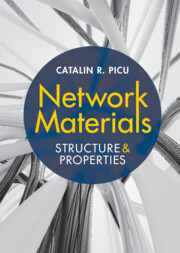Book contents
- Network Materials
- Network Materials
- Copyright page
- Contents
- Preface
- 1 Introduction
- 2 Fibers and Fiber Bundles
- 3 Fiber Interactions
- 4 Network Structure and Geometric Parameters
- 5 Affine Deformation
- 6 Mechanical Behavior and Relation to Structural Parameters
- 7 Constitutive Formulations for Network Materials
- 8 Strength and Toughness of Network Materials
- 9 Time Dependent Behavior
- 10 Networks with Fiber Surface Interactions
- 11 Composite Networks
- Index
- References
5 - Affine Deformation
Published online by Cambridge University Press: 15 September 2022
- Network Materials
- Network Materials
- Copyright page
- Contents
- Preface
- 1 Introduction
- 2 Fibers and Fiber Bundles
- 3 Fiber Interactions
- 4 Network Structure and Geometric Parameters
- 5 Affine Deformation
- 6 Mechanical Behavior and Relation to Structural Parameters
- 7 Constitutive Formulations for Network Materials
- 8 Strength and Toughness of Network Materials
- 9 Time Dependent Behavior
- 10 Networks with Fiber Surface Interactions
- 11 Composite Networks
- Index
- References
Summary
Affine models have been used traditionally to describe the deformation of networks. Due to their prevalence, this chapter is dedicated to the review of such formulations. The chapter begins with a brief review of finite kinematics of continua and the definition of stress measures. Further, the affine deformation is defined and several parameters used to quantify the degree of nonaffinity are introduced. An expression is derived to quantify the evolution of preferential fiber orientation during affine deformation. Several constitutive models based on the affine deformation assumption are discussed: The affine models for molecular networks of flexible and semi-flexible filaments, and the affine model for athermal networks. The stress–optical law is reviewed, and its relation to the affine deformation models is discussed.
Keywords
Information
- Type
- Chapter
- Information
- Network MaterialsStructure and Properties, pp. 128 - 145Publisher: Cambridge University PressPrint publication year: 2022
